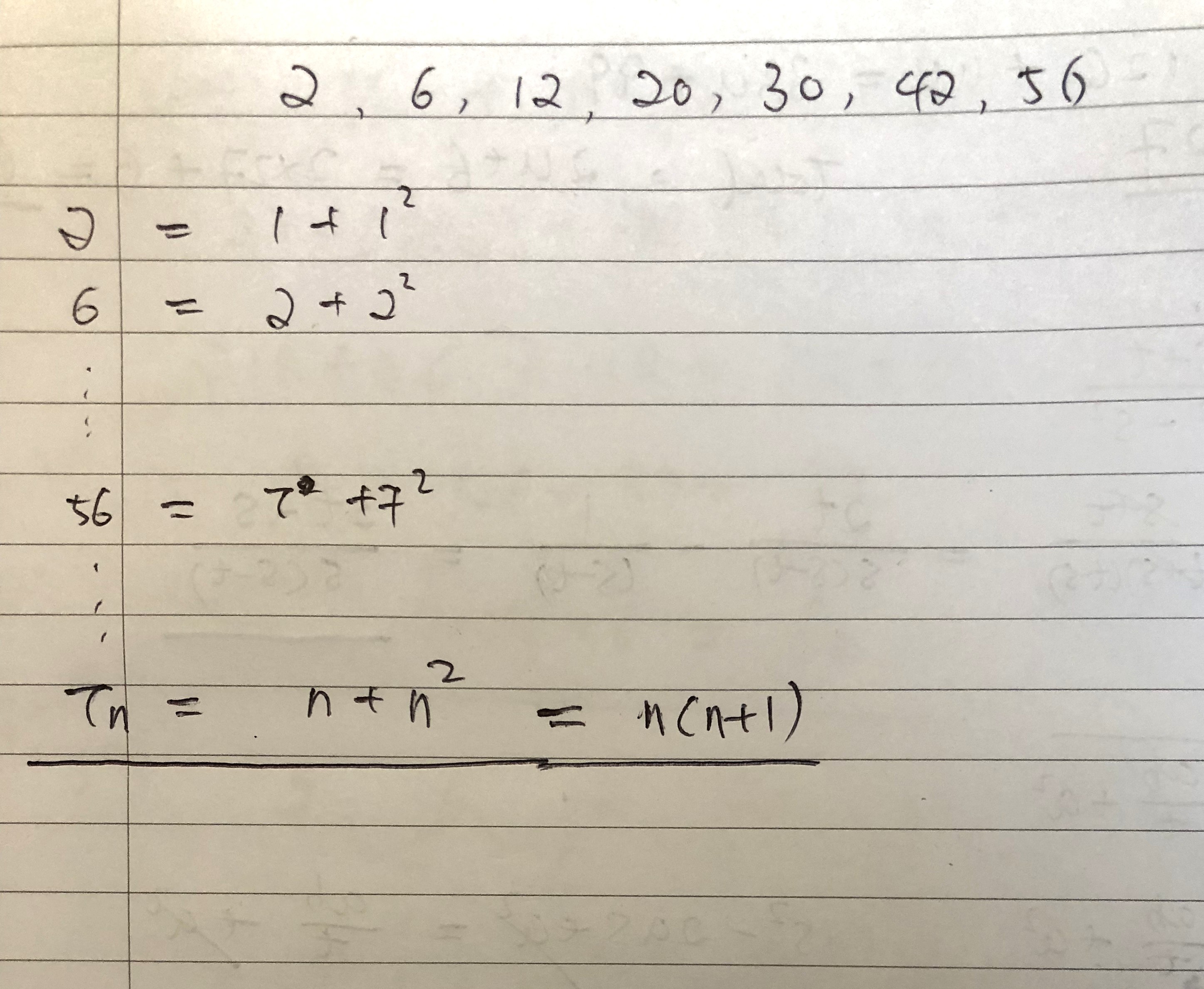Ask Singapore Homework?
Upload a photo of a Singapore homework and someone will email you the solution for free.

Question
Secondary 1 | Maths
One Answer Below
Anyone can contribute an answer, even non-tutors.

How do you find the general term when the difference between each term is increasing by a certain amount (in this case the difference is increasing by 2 each time)? The answer is n(n+1), but I want to if there’s a specific formula for these type of questions. Thank you!
Rather, the question expects you to discover that :
2 = 2 x 1
6 = 3 x 2
12 = 4 x 3
20 = 5 x 4
30 = 6 x 5
42 = 7 x 6
56 = 8 x 7
How would that work out?
8 = 4*2
19 = 19*1
33= 3*11
???
When such questions are set in the exam, the pattern has to be formed first by the setter. He/she will then put in numbers that satisfy the pattern
½(3n² + 13n)
Another example :
50,55(+5),63(+8),74(+11),88(+14),105(+17),..
The pattern here would be
½(3n² + n + 96)
And yet another one :
23,59(+36),98(+39),140(+42),185(+45),...
The pattern here would be
½(3n² + 63n - 20)
As you can see there's no fixed pattern even though they all increase by more than 3 of the previous increase.
It depends on the number you start with and what the first increment is.
First term :
8 = 5 + 3
= 1 x 5 + 3 x 1
2nd term :
19 = 8 + 11
= 5 + 3 + 5 + 3 x 2
= 2 x 5 + 3 x (1 + 2)
3rd term :
33 = 19 + 14
= 2 x 5 + 3 + (1 + 2) + 5 + 3 x 3
= 3 x 5 + 3 x (1 + 2 + 3)
4th term :
50 = 33 + 17
= 3 x 5 + 3 x (1 + 2 + 3) + 5 + 3 x 4
= 4 x 5 + 3 x (1 + 2 + 3 + 4)
5th term :
70 = 50 + 20
= 4 x 5 + 3 x (1 + 2 + 3 + 4) + 5 + 3 x 5
= 5 x 5 + 3 x (1 + 2 + 3 + 4 + 5)
So for the nth term,
nth term = n x 5 + 3 x (1 + 2 + 3 +... + (n-2) + (n - 1) + n)
Now for the series
(1 + 2 + 3 +... + (n-2) + (n - 1) + n) ,
Notice that you can pair the numbers
1 + n = n + 1
2 + (n-1) = n + 1
3 + (n-2) = n + 1
And so on.
Each pair's total is n + 1. The number of pairs is ½ of the total number of terms in the series (which is n) , so it equals ½n.
so the sum = number of pairs x total of each pair
=½n(n + 1)
Therefore
nth term = n x 5 + 3 x (1 + 2 + 3 +... + (n-2) + (n - 1) + n)
= 5n + 3 x (½n(n + 1))
= 5n + 3/2 n² + 3/2 n
= 3/2 n² + 13/2 n
= ½(3n² + 13n)
If the difference increases by u each time, then the first part of the general term to be found could be said to be
u/2 n²
But you will still need to figure out the other parts of the term
8,19,34,53,76
The pattern is : 2n² + 5n + 1
Modify the previous 2nd example,
50,55(+5),64(+9),77(+13),94(+17),115(+21),..
Pattern becomes : 2n² - n + 49
Modify the 3rd last example,
23,59(+36),99(+40),143(+44),191(+48),...
Pattern becomes: 2n² + 30n - 9
Now 2n² = 4/2 n²
You can try on your own for other difference increases. But the difficult part is to derive the rest of the expression as it would involve some trial and error.
I would recommend that you first try to spot a pattern, then work towards the obtaining the final expression
(something like my example for ½(3n² + 13n) .
8,19,33,50,70
8= 5+3
...
19= 8+11
...
33= 19+ 14
How do you pick the numbers for the first term (why specifically
8= 5+3, and not 8= 4+4?)?I managed to see why you picked the specific numbers for the second and 3rd terms, but not the first.
I also tried doing this for when the difference in the numbers +4 each time
8, 19, 34, 53, 76
(The first pairing is probably wrong)
First term
8= 4+4
=1*4 + 4*1
Second term
19= 8+ 11
4*2 + ???
You could also do it like this :
For 8,19,33,50,70 :
First term :
8
2nd term :
19 = 8 + 11
= 8 + 8 + 3
= 8 x 2 + 3 x 1
3rd term :
33 = 19 + 14
= 8 x 2 + 3 x 1 + 8 + 3 x 2
= 8 x 3 + 3 x (1 + 2)
4th term :
50 = 33 + 17
= 8 x 3 + 3 x (1 + 2) + 8 + 3 x 3
= 8 x 4 + 3 x (1 + 2 + 3)
5th term :
70 = 50 + 20
= 8 x 4 + 3 x (1 + 2 + 3) + 8 + 3 x 4
= 8 x 5 + 3 x (1 + 2 + 3 + 4)
So for the nth term,
nth term = 8 x n + 3 x (1 + 2 + 3 +... + (n-2) + (n - 1) )
Now for the series
(1 + 2 + 3 +... + (n-2) + (n - 1) + n) ,
Sum = ½(n -1)(n - 1 + 1)
= ½(n - 1)(n)
= ½n² - ½n
Therefore,
nth term = 8 x n + 3(½n² - ½n)
= 8n + 3/2 n² - 3/2 n
3/2 n² + 13/2 n
= ½ (3n² + 13n)
There's no need to specifically pick the numbers 5 + 3 , it all depends on what insight/discovery you make of the sequence first.
As for why not 4 + 4, it's because there is no relation to the increase of 3 for every difference. Splitting 8 into 5 + 3 means another 3 is created , which can be grouped with the other 3s in the sum
First term :
8 = 1 + 7
= 1 + 4 + 3
= 1 + 4 x 1 + 3 x 1
2nd term :
19 = 8 + 11
= 1 + 4 x 1 + 3 + 4 x 2 + 3
= 1 + 4 x (1 + 2) + 3 x 2
3rd term :
34 = 19 + 15
= 1 + 4 x 3 + 3 x 2 + 4 x 3 + 3
= 1 + 4 x (1 + 2 + 3) + 3 x 3
4th term :
53 = 34 + 19
= 1 + 4 x (1 + 2 + 3) + 3 x 3 + 4 x 4 + 3
= 1 + 4 x (1 + 2 + 3 + 4) + 3 x 4
5th term :
76 = 53 + 23
= 1 + 4 x (1 + 2 + 3 + 4) + 3 x 4 + 4 x 5 + 3
= 1 + 4 x (1 + 2 + 3 + 4 + 5) + 3 x 5
So for the nth term,
nth term
1 + 4 x (1 + 2 + 3 +... + (n-2) + (n-1) + n) + 3 x n
= 1 + 4( ½n(n+1) ) + 3n
= 1 + 2n² + 2n + 3n
= 2n² + 5n + 1
First term :
8 = 1 + 7
2nd term :
19 = 8 + 11
= 1 + 7 + 7 + 4
= 1 + 7 x 2 + 4 x 1
3rd term :
34 = 19 + 15
= 1 + 7 x 2 + 4 x 1 + 7 + 4 x 2
= 1 + 7 x 3 + 4 x (1 + 2)
4th term :
53 = 34 + 19
= 1 + 7 x 3 + 4 x (1 + 2) + 7 + 4 x 3
= 1 + 7 x 4 + 4 x (1 + 2 + 3)
5th term :
76 = 53 + 23
= 1 + 7 x 4 + 4 x (1 + 2 + 3) + 7 + 4 x 4
= 1 + 7 x 5 + 4 x (1 + 2 + 3 + 4)
So for the nth term,
nth term
1 + 7 x n + 4 x (1 + 2 + 3 +... + (n-2) + (n-1) )
= 1 + 7n + 4(½(n - 1)(n)
= 1 + 7n + 2n² - 2n
= 2n² + 5n + 1
See 1 Answer





